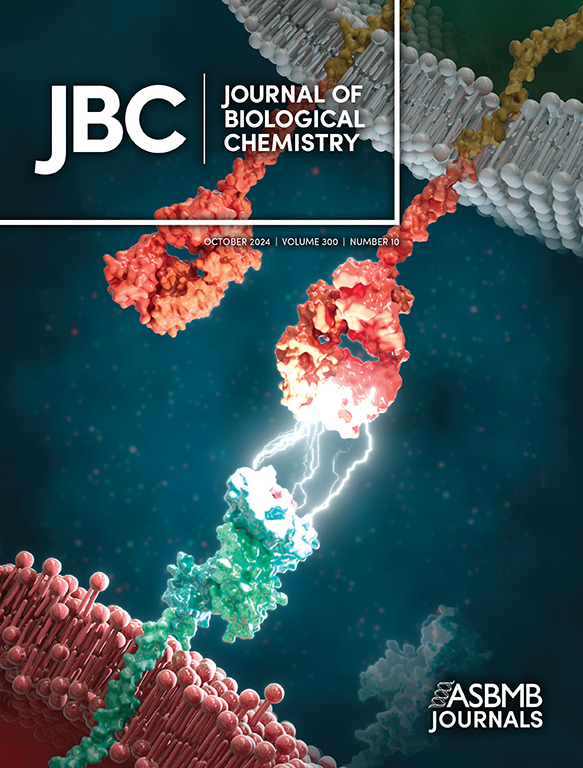糖苷水解酶家族甲基聚焦酶的底物识别及催化机制研究
IF 4
2区 生物学
Q2 BIOCHEMISTRY & MOLECULAR BIOLOGY
引用次数: 0
摘要
鼠李糖半乳糖酸II是最复杂的植物细胞壁碳水化合物之一,由13种不同的糖和21种不同的糖苷键组成。它富含水果和放纵食品,如巧克力和葡萄酒,使其在人类饮食中很常见。人类结肠共生拟杆菌(Bacteroides thetaiotaomicron)表达22种酶的联盟来代谢鼠李糖半乳乳酸II,其中一些酶专门针对鼠李糖半乳乳酸II所特有的糖。这些酶家族中的一些仍然描述得很差,因此,我们对鼠李糖半乳酪酸II代谢的了解是有限的。其中最不为人知的是糖苷水解酶(GH)家族139,其目标是α1,2- 20 -甲基L-聚焦键,这是一种在任何其他植物细胞壁复合聚糖中都没有发现的糖残基。虽然建立酶BT0984被放置在RG-II降解途径中,但没有GH139结构或催化蓝图。我们报道了BT0984和第二个同系物的晶体结构,并揭示了该家族的反立体化学作用。利用这些数据,我们采用了一种诱变策略,在分子动力学的支持下,确定了重要的底物结合和催化残基,绘制了GH139家族中这些残基的图谱,揭示了底物O2甲基相互作用的重要性。我们提出了一种使用非典型Asn作为催化碱基的催化机制,该机制与GH95家族的L-聚焦酶/L-半乳糖苷酶有相似之处。本文章由计算机程序翻译,如有差异,请以英文原文为准。
Understanding the substrate recognition and catalytic mechanism of methyl fucosidases from glycoside hydrolase family 139
Rhamnogalacturonan II is one of the most complex plant cell wall carbohydrates and is composed of 13 different sugars and 21 different glycosidic linkages. It is abundant in fruit and indulgence foods, such as chocolate and wine, making it common in the human diet. The human colonic commensal Bacteroides thetaiotaomicron expresses a consortium of 22 enzymes to metabolise rhamnogalacturonan II, some of which exclusively target sugars unique to rhamnogalacturonan II. Several of these enzyme families remain poorly described, and, consequently, our knowledge of rhamnogalacturonan II metabolism is limited. Chief among the poorly understood activities is glycoside hydrolase (GH) family 139, with targets α1,2-2O -methyl L-fucoside linkages, a sugar residue a sugar not found in any other plant cell wall complex glycans. Although the founding enzyme BT0984 was placed in the RG-II degradative pathway, no GH139 structure or catalytic blueprint had been available. We report the crystal structures of BT0984 and a second homologue, and reveal that the family operates with inverting stereochemistry. Using this data we undertook a mutagenic strategy, backed by molecular dynamics, to identify the important substrate binding and catalytic residues, mapping these residues throughout the GH139 family revealing the importance of the O 2 methyl interaction of the substrate. We propose a catalytic mechanism that uses a non-canonical Asn as a catalytic base and shares similarity with L-fucosidases/L-galactosidases of family GH95.
求助全文
通过发布文献求助,成功后即可免费获取论文全文。
去求助
来源期刊

Journal of Biological Chemistry
Biochemistry, Genetics and Molecular Biology-Biochemistry
自引率
4.20%
发文量
1233
期刊介绍:
The Journal of Biological Chemistry welcomes high-quality science that seeks to elucidate the molecular and cellular basis of biological processes. Papers published in JBC can therefore fall under the umbrellas of not only biological chemistry, chemical biology, or biochemistry, but also allied disciplines such as biophysics, systems biology, RNA biology, immunology, microbiology, neurobiology, epigenetics, computational biology, ’omics, and many more. The outcome of our focus on papers that contribute novel and important mechanistic insights, rather than on a particular topic area, is that JBC is truly a melting pot for scientists across disciplines. In addition, JBC welcomes papers that describe methods that will help scientists push their biochemical inquiries forward and resources that will be of use to the research community.
 求助内容:
求助内容: 应助结果提醒方式:
应助结果提醒方式:


